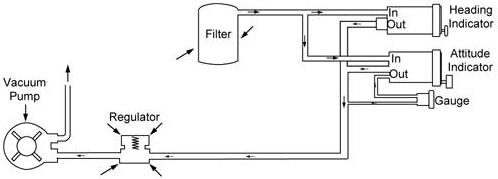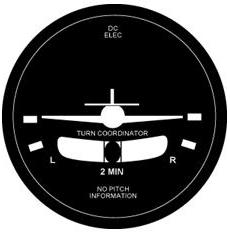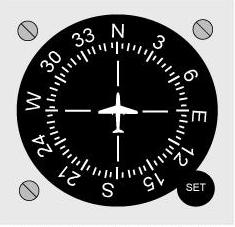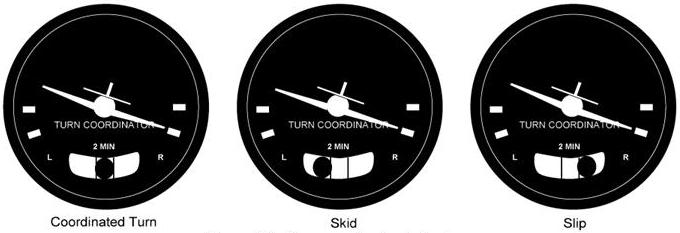| GYROSCOPIC FLIGHT INSTRUMENTS
Several flight instruments utilize the properties of a gyroscope for their
operation. The most common instruments containing gyroscopes are the turn
coordinator, heading indicator, and the attitude indicator. To understand how
these instruments operate requires a knowledge of the instrument power systems,
gyroscopic principles, and the operating principles of each instrument.
Sources of Power for Gyroscopic Operation
In some airplanes, all the gyros are vacuum, pressure, or electrically
operated; in others, vacuum, or pressure systems provide the power for the
heading and attitude indicators, while the electrical system provides the power
for the turn coordinator.
Vacuum or Pressure System
The vacuum or pressure system spins the gyro by drawing a stream of air
against the rotor vanes to spin the rotor at high speeds essentially the same as
a water wheel or turbine operates. The amount of vacuum or pressure required for
instrument operation varies with manufacture and is usually between 4.5 to 5.5
in. Hg.
Engine-Driven Vacuum Pump
One source of vacuum for the gyros installed in light aircraft is the
vane-type engine-driven pump which is mounted on the accessory case of the
engine. Pump capacity varies in different aircraft, depending on the number of
gyros to be operated.
A typical vacuum system consists of an
engine-driven vacuum pump, regulator, air filter, gauge, tubing, and manifolds
necessary to complete the connections. The gauge is mounted in the airplane
instrument panel and indicates the amount of pressure in the system. [Figure
3-5]
The air filter prevents foreign matter from entering the vacuum or
pressure system. Airflow is reduced as the master filter becomes dirty; this
results in a lower reading on the vacuum or pressure gauge.
Gyroscopic Principles
Any spinning object exhibits gyroscopic properties; however, a wheel
designed and mounted to utilize these properties is called a gyroscope. Two
important design characteristics of an instrument gyro are great weight or high
density for size and rotation at high speeds with low friction bearings. The
mountings of the gyro wheels are called “gimbals” which may be circular rings,
rectangular frames, or a part of the instrument case itself.
There are two general types of mountings; the type used depends upon
which property of the gyro is utilized. A freely or universally mounted
gyroscope is free to rotate in any direction about its center of gravity. Such a
wheel is said to have three planes of freedom. The wheel or rotor is free to
rotate in any plane in relation to the base and is so balanced that with the
gyro wheel at rest, it will remain in the position in which it is placed.
Restricted or semirigidly mounted gyroscopes are those mounted so that one of
the planes of freedom is held fixed in relation to the base.
There are two fundamental properties of gyroscopic action; rigidity
in space, and precession.
 |
Rigidity in space can best be explained by applying Newton’s First Law
of Motion which states, “a body at rest will remain at rest; or if in
motion in a straight line, it will continue in a straight line unless
acted upon by an outside force.” An example of this law is the rotor of a
universally mounted gyro. |
| Figure 3-5.—Typical pump-driven vacuum system. |
| When the wheel is spinning, it exhibits the
ability to remain in its original plane of rotation regardless of how the base
is moved. However, since it is impossible to design bearings without some
friction present, there will be some deflective force upon the wheel.
The flight instruments using the gyroscopic property of rigidity for their
operation are the attitude indicator and the heading indicator; therefore, their
rotors must be freely or universally mounted.
| The second property of a gyroscope—precession—is the
resultant action or deflection of a spinning wheel when a deflective force
is applied to its rim. When a deflective force is applied to the rim of a
rotating wheel, the resultant force is 90° ahead in the direction of
rotation and in the direction of the applied force. The rate at which the
wheel precesses is inversely proportional to the speed of the rotor and
proportional to the deflective force. The force with which the wheel
precesses is the same as the deflective force applied (minus the friction
in the bearings). If too great a deflective force is applied for the
amount of rigidity in the wheel, the wheel precesses and topples over at
the same time. [Figure 3-6] |
|
|
Figure 3-6.—Precession of a gyroscope resulting from an applied
deflective force. | Figure 3-7.
 |
Turn Coordinator
The turn coordinator shows the yaw and roll of the aircraft around the
vertical and longitudinal axes.
When rolling in or rolling out
of a turn, the miniature airplane banks in the direction of the turn.
The miniature airplane does not indicate the angle of bank, but
indicates the rate of turn. When aligned with the turn index, it
represents a standard rate of turn of 3° per second. [Figure
3-7] |
Figure 3-8.—Turn coordinator indications.
The inclinometer of the turn
coordinator indicates the coordination of aileron and rudder. The ball indicates
whether the airplane is in coordinated flight or is in a slip or skid. [Figure
3-8]
The Heading Indicator
 |
The heading indicator (or directional gyro) is fundamentally a
mechanical instrument designed to facilitate the use of the magnetic
compass. Errors in the magnetic compass are numerous, making straight
flight and precision turns to headings difficult to accomplish,
particularly in turbulent air. A heading indicator, however, is not
affected by the forces that make the magnetic compass difficult to
interpret. [Figure 3-9]
The operation of the heading indicator depends upon the principle of
rigidity in space. The rotor turns in a vertical plane, and fixed to the
rotor is a compass card. Since the rotor remains rigid in space, the
points on the card hold the same position in space relative to the
vertical plane. As the instrument case and the airplane revolve around the
vertical axis, the card provides clear and accurate heading
information. |
|
Figure 3-9. |
| Because of precession, caused chiefly by friction,
the heading indicator will creep or drift from a heading to which it is set.
Among other factors, the amount of drift depends largely upon the condition of
the instrument. If the bearings are worn, dirty, or improperly lubricated, the
drift may be excessive.
Bear in mind that the heading indicator is not direction-seeking, as is
the magnetic compass. It is important to check the indications frequently and
reset the heading indicator to align it with the magnetic compass when required.
Adjusting the heading indicator to the magnetic compass heading should be done
only when the airplane is in wings-level unaccelerated flight; otherwise
erroneous magnetic compass readings may be obtained.
The bank and pitch limits of the heading indicator vary with the
particular design and make of instrument. On some heading indicators found in
light airplanes, the limits are approximately 55° of pitch and 55° of bank. When
either of these attitude limits is exceeded, the instrument “tumbles” or
“spills” and no longer gives the correct indication until reset. After spilling,
it may be reset with the caging knob. Many of the modern instruments used are
designed in such a manner that they will not tumble.
The Attitude Indicator
 |
The attitude indicator, with its miniature aircraft and horizon bar,
displays a picture of the attitude of the airplane. The relationship of
the miniature aircraft to the horizon bar is the same as the relationship
of the real aircraft to the actual horizon. The instrument gives an
instantaneous indication of even the smallest changes in attitude. [Figure
3-10]
The gyro in the attitude indicator is mounted on a horizontal plane and
depends upon rigidity in space for its operation. The horizon bar
represents the true horizon. This bar is fixed to the gyro and remains in
a horizontal plane as the airplane is pitched or banked about its lateral
or longitudinal axis, indicating the attitude of the airplane relative to
the true horizon. |
|
Figure 3-10. |
| An adjustment knob is provided with which the
pilot may move the miniature airplane up or down to align the miniature airplane
with the horizon bar to suit the pilot’s line of vision. Normally, the miniature
airplane is adjusted so that the wings overlap the horizon bar when the airplane
is in straight-and-level cruising flight. The pitch and bank limits depend upon
the make and model of the instrument. Limits in the banking plane are usually
from 100° to 110°, and the pitch limits are usually from 60° to 70°. If either
limit is exceeded, the instrument will tumble or spill and will give incorrect
indications until restabilized. A number of modern attitude indicators will not
tumble.
 |
|
Figure 3-11.—Various indications on the attitude
indicator. | Every pilot should be able to
interpret the banking scale. Most banking scale indicators on the top of the
instrument move in the same direction from that in which the airplane is
actually banked. Some other models move in the opposite direction from that in
which the airplane is actually banked. This may confuse the pilot if the
indicator is used to determine the direction of bank. This scale should be used
only to control the degree of desired bank. The relationship of the miniature
airplane to the horizon bar should be used for an indication of the direction of
bank. [Figure 3-11] The attitude indicator is reliable and the most realistic
flight instrument on the instrument panel. Its indications are very close
approximations of the actual attitude of the airplane.
|






